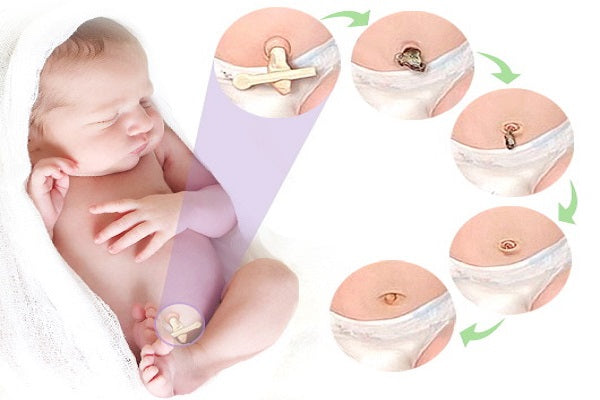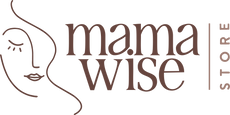Picture this. The birth is now over and you've now entered the dreamy phase of baby gazing.
Staring at your beautiful newborn creation, you repeatedly inspect each finger and teeny fingernail, you follow the curves of their ear and their little lips, and can't stop lightly stroking their little head and face.
Then, when you change their nappy you catch sight of the remainder of your incredible in-utero connection: the cord stump.
The once life-line. The once power cord between yourself, the placenta and your baby.
Then the mama brain kicks in:
-
- What do I need to do with it?
- Does it hurt my baby if I move it?
- Can I get it wet?
- Can I take that hard, plastic clamp off?
- How long does it take to fall off?
- Is that colour normal?

The cord stump
At some point after the birth the cord will be clamped and/or cut. What remains after this is the 'cord stump', along with either a cord clamp or a cotton cord tie, if you've decided to use this instead.
How much of a stump is left depends on where it's cut.
Some care providers leave approximately 2-3cm of cord, whilst others leave a 5-7cm stump.
In my experience as a doula I generally see cord stumps on the shorter side in hospital/obstetric-led settings.
Whilst cord stumps left at homebirths and/or midwifery-led birth centres tend to be on the longer side. This, I consider just an interesting observation.
Then there are the babies that remain attached to their cord and placenta in a semi-lotus or lotus birth. In these cases there is neither a cord tie or clamp involved at all.
It's been thought that 'a long stump could possibly increase the risk of infection because it is harder to keep clean and dry'. However, this has not been demonstrated in any study.
It's also been thought that the length of cord stump left can influence the resulting belly button shape, i.e an 'innie' or an 'outtie'. With an innie being more likely to form with a longer cord stump, and an outtie being formed after a shorter cord stump.
Currently there is "no evidence to prove this is true" but I'd love see a longitudinal study on it!
The more agreed-upon view is that the result depends on how the scar tissue forms.
Outties having a little more scar tissue therefore protruding whilst innies have less, curving inwards.
Anecdotally, I've heard from many midwives that leaving more (than less) cord length on the stump can help it heal quicker.

What to expect
The cord stump may take anywhere from 5 to 15 days to completely dry out and fall off.
Keeping this cord stump clean and dry helps this process. Otherwise baby can get a mucky cord stump with redness, oozing, irritation and potentially infection. This often delays the process of drying out and falling off.
The fresh, limp cord stump will go through natural changes over the many days following the birth.
It will dry out, shrink, harden, change colour and eventually fall off. Much like the process of a scab forming on our skin.

Mother Nature will take good care of it with your support of keeping it clean and dry.
You don't need to go overboard with alcohol swaps or antiseptic chemicals - as was once done. The 3 simple steps below will help.
3 TIPS FOR NATURAL CARE
Focus your care on the base of the cord stump, where it meets baby's skin.
1. Keep it dry
- Fold down any nappy coverage and give the area some fresh air and perhaps indirect sunlight daily.
- Be sure to change wet nappies regularly so there's no leakage up to the cord stump.
- Check that the edge of the nappy, or pants/clothing is not rubbing on the cord stump irritating it.
- Consider using a onesie jumpsuits to avoid waistlines rubbing on cord stump.
- If fully bathing your baby at this stage, spot-dry the area well with a soft cloth or cotton pad and also allow some air-dry time. Ensuring this area is fully dry after a bath will require a little attention.
- Consider spot-cleaning/sponge-cleaning your baby instead of the full immersion bath, until the cord stump falls off. You really only need to focus on their nappy area and other body creases.
2. Keep it clean
- Your baby's body will be doing most of the work detaching the cord stump itself, but ensuring it remains clean will definitely help.
- By keeping it dry it helps keep it clean, as the skin's natural microbes love to party in any warm, wet areas.
- Powdered herbs can help with both drying and cleanliness. For this purpose herbs with gentle anti-inflammatory, drying, antimicrobial and skin healing properties can work wonders. Anecdotal evidence shows that cord stumps that had herbs used on them fell off around Day 3 as opposed to the standard 1-2 weeks! Use this powder all around the base of the cord stump at each nappy change.
- Avoid chemicals, antiseptics and alcohol-based solutions as a preventative measure. These should only be considered if an infection is confirmed, but always follow the guidance of your careprovider here.
- It can get a little smelly whilst healing, but the powdered herbs can also help with this.
3. Keep out of it
- Avoid fiddling, touching, lifting, pulling. Do check it daily at nappy changes to see how it's healing. Look for any radiating skin redness, pus or bleeding or other changes. If unsure contact your care provider.
- Sometimes there may be a touch of dried blood and ooze but it should pass quickly.
- Although pretty rare, signs of infection include: fever, red, swollen and warm cord stump and surrounding skin, yellow or green pus, continual bleeding and/or foul odour. With any of these please contact your care provider.
The cord stump will eventually form a scab at its base, then fall off. You may find it by surprise, having detached itself at some point between nappy changes!
Once it has fallen off, there's usually a small area that needs to heal over before the job is completely done. A little dried blood or ooze (like any skin scab) may be seen. Continue to keep it dry and clean (and perhaps coated with the powdered herbs) until completely healed over.
The result: your baby's belly button.
An infinite reminder of your time together as one 💞

